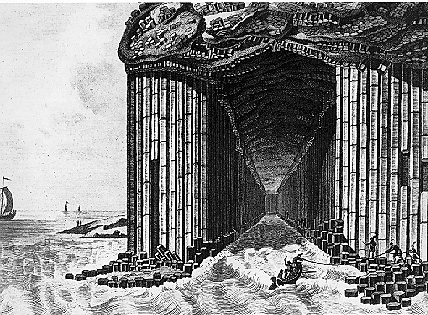The Hebrides are probably the best-known group of Scottish islands off the west coast of Scotland. They are composed of the oldest rock formations in the British Isles. Fingal’s Cave on the island of Staffa is the most famous of all the caves. Nowhere else is there a sea-cave formed completely in hexagonally-jointed basalt. The size, sounds, colors, and remarkable symmetry of this 227-foot cavern is viewed by a natural crude walkway that allows exploring visitors to go far inside. The impact of the cave on all those who enter it is likely to be remembered for life.
In the 1800’s it was common for wealthy young men to undertake a “Grand Tour” of Europe to gain perspective on life. Felix Mendelssohn, being from a wealthy family, went on such a tour. His tour lasted four years and took him through most of the major countries and cities of the time. During his travels he went to Scotland, where he visited the Hebrides and the renowned Fingal’s Cave with his friend Klingemann. In order to see the rock formations, they set out on the newly introduced paddle steamer service. The sea was wild, the weather bad, and all the passengers were ill. Here Klingemann tells of the adventures at Staffa:
“We were put out into boats and lifted by the hissing sea up the pillar stumps to the celebrated Fingal’s Cave. A greener roar of waves surely never rushed into a stranger cavern – its many pillars making it look like the inside of an immense organ, black and resounding, and absolutely without purpose, and quite alone, the wide gray sea within and without.”
With conditions such, Mendelssohn can hardly have enjoyed seeing Fingal’s Cave since he was so seasick. However the visit to Staffa, and the sight and sound of the Atlantic swell tumbling into the cave, made a profound impression on him. Tremendously affected by the loneliness and beauty of this immense place, he quickly wrote down what would later become the opening notes of an overture. The most striking aspect of this overture was its successful tone-painting. Mendelssohn portrays overcast skies, gray seas, and barren a landscape. We can hear the breaking of the waves, almost see the basalt columns and strange colors, and above all, experience the overwhelming vastness of the cavern.
Mendelssohn worked on this composition for many years fine tuning his musical decisions. He wanted the listener to be immersed in the experience, just as he had been when he viewed the cave. Among the numerous sketches, four complete versions with distinct titles exist of this work: The Hebrides Overture (1829), Overture to the Solitary Island (Die einsame Insel) (1830), The Isle of Fingal (1832), and Fingal’s Cave (Fingalshöhle) (1835).
The Hebrides Overture
"Fingal's Cave," Op. 26
Composed in 1830-32
By Felix Mendelssohn







I would like to know what the author Klingemann, who travelled to Staffa with Mendelsohnn wrote. Once I happened to see a movie on Mendelsohnn where while the overture The Hebrides was played, the words were seen as a caption. I have not been able to find the movie or the author of those words which were marvelous. I hope you may have them or tell me where I can find them I have searched in Goethe but don’ t find it there. Now that I know about Klingemann, maybe you have more information